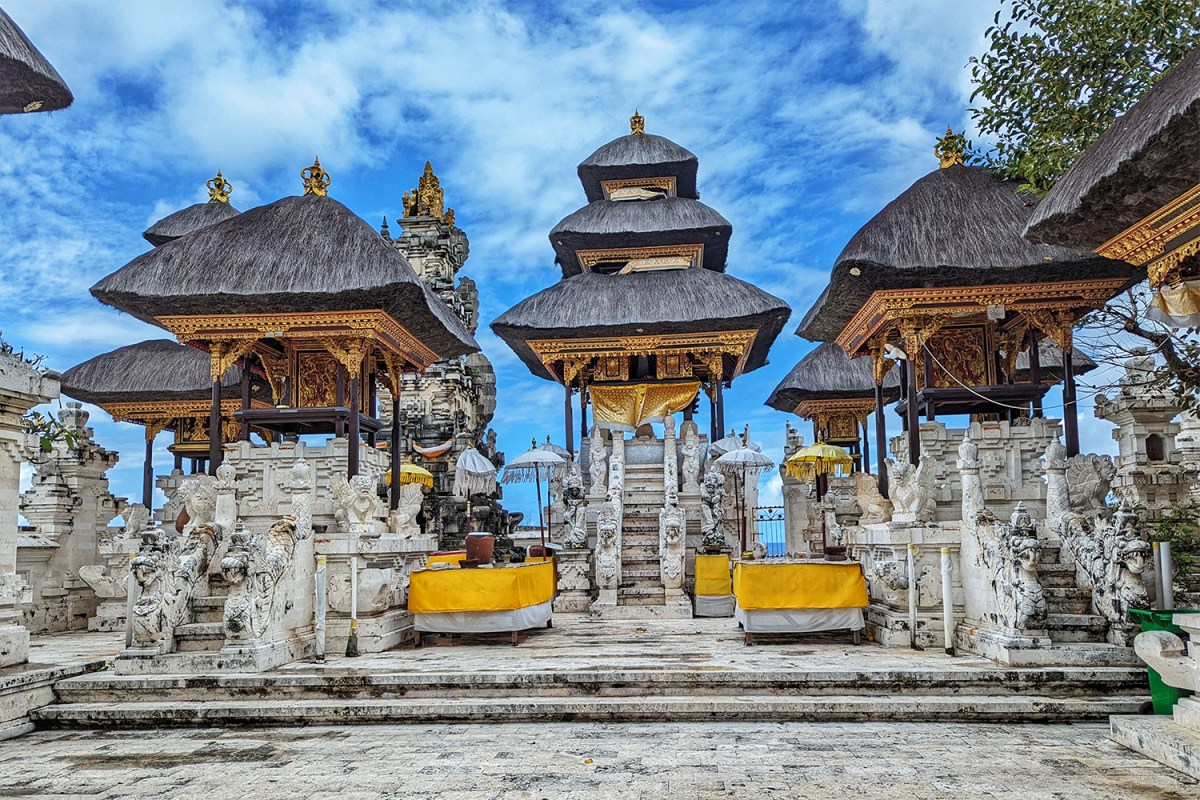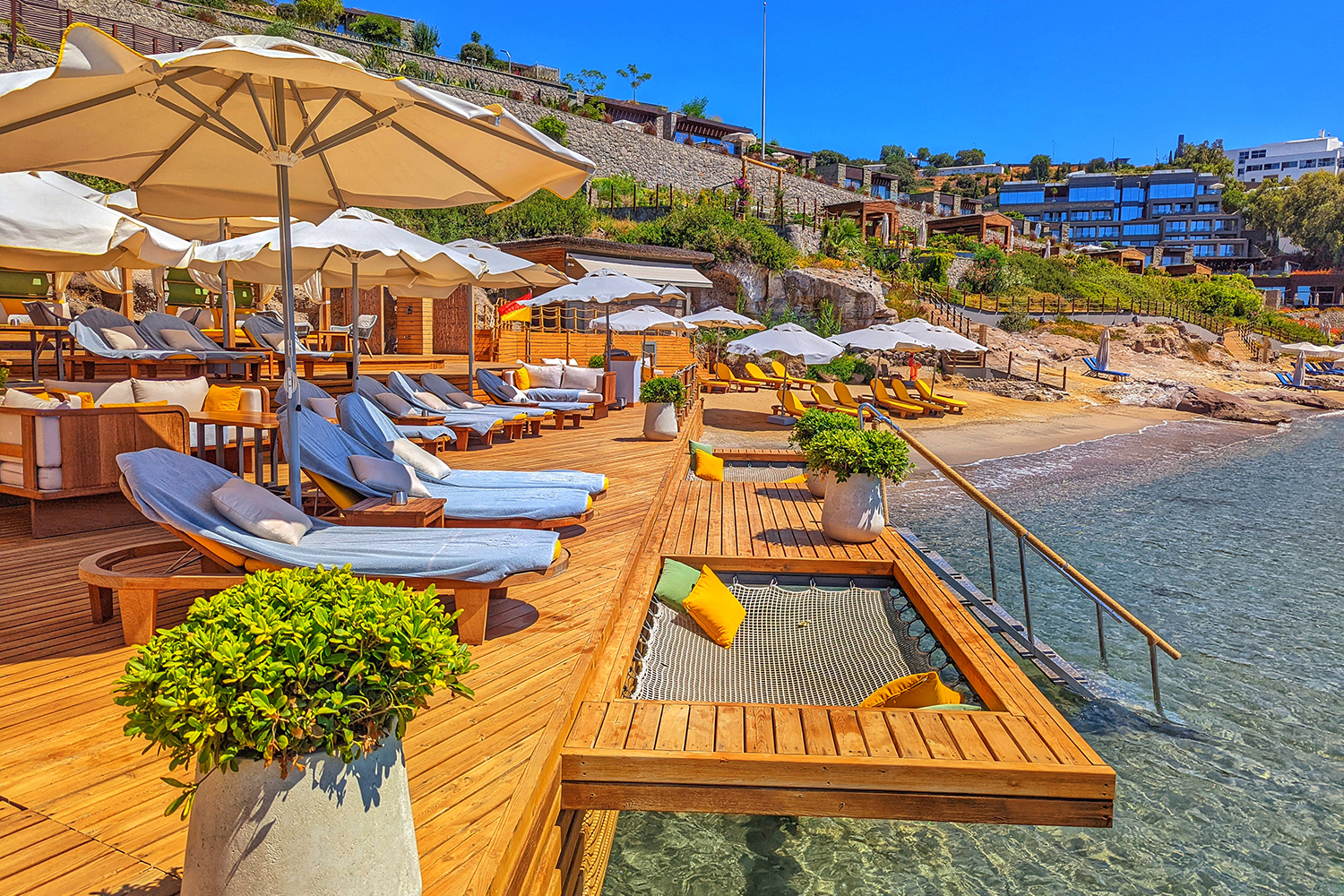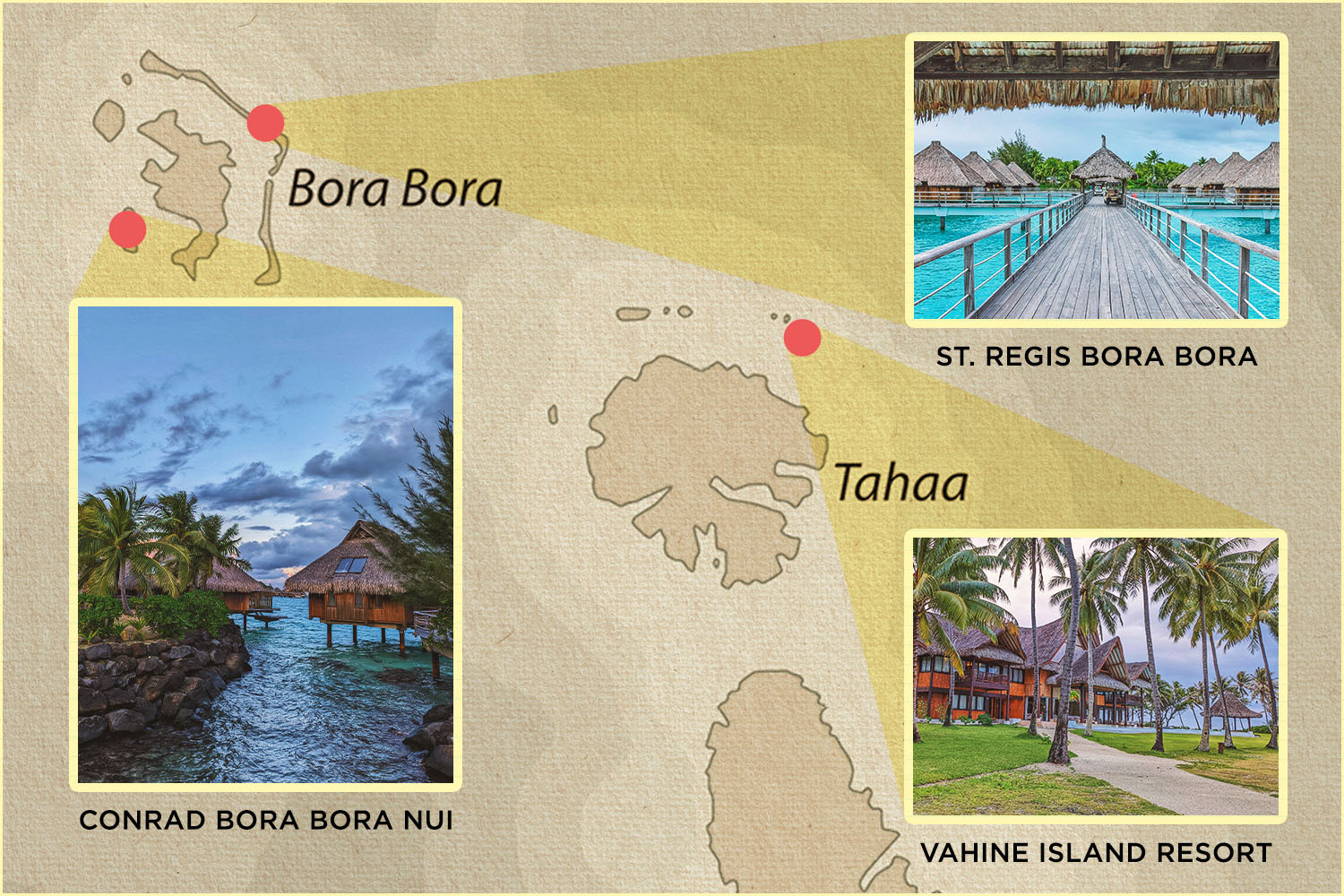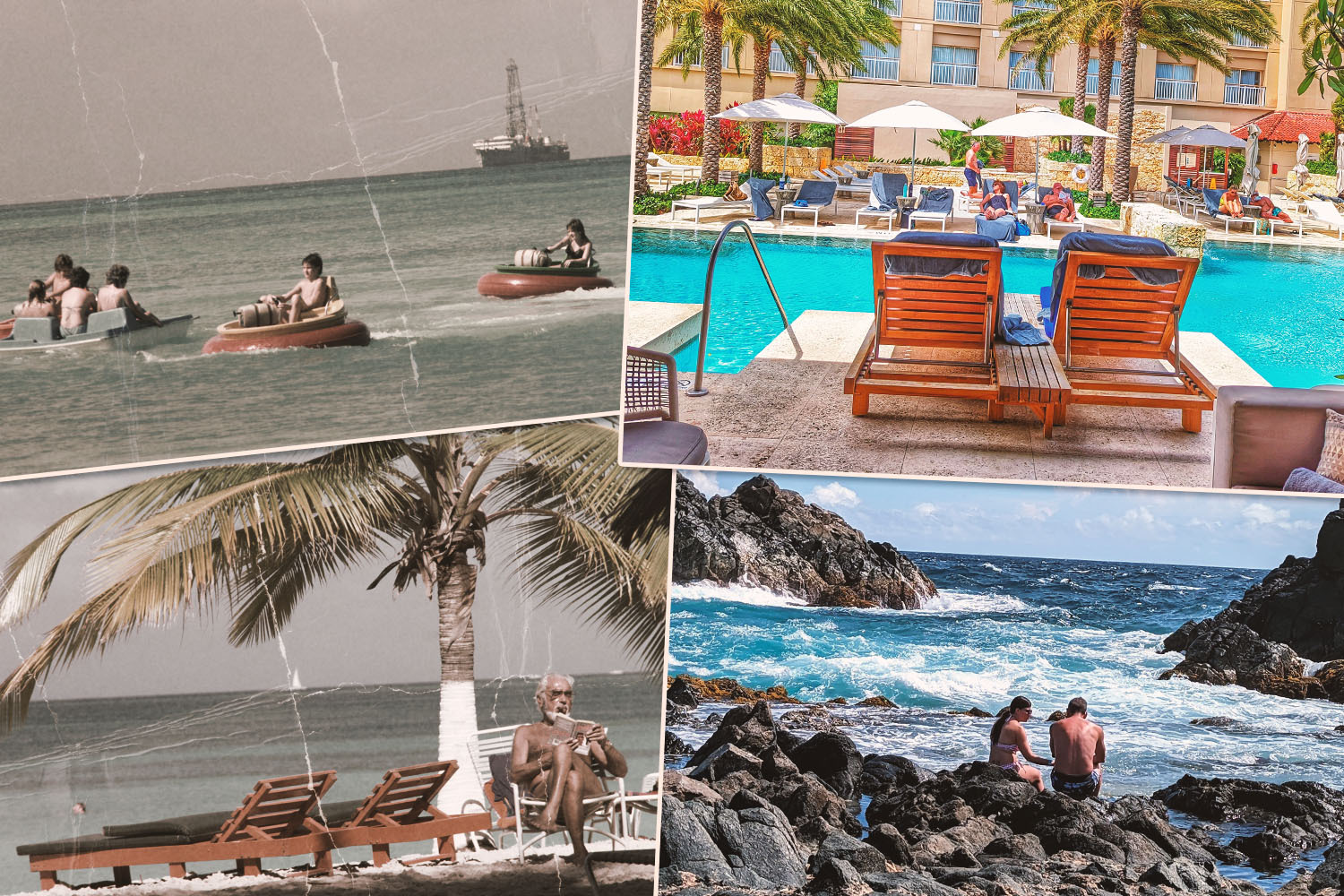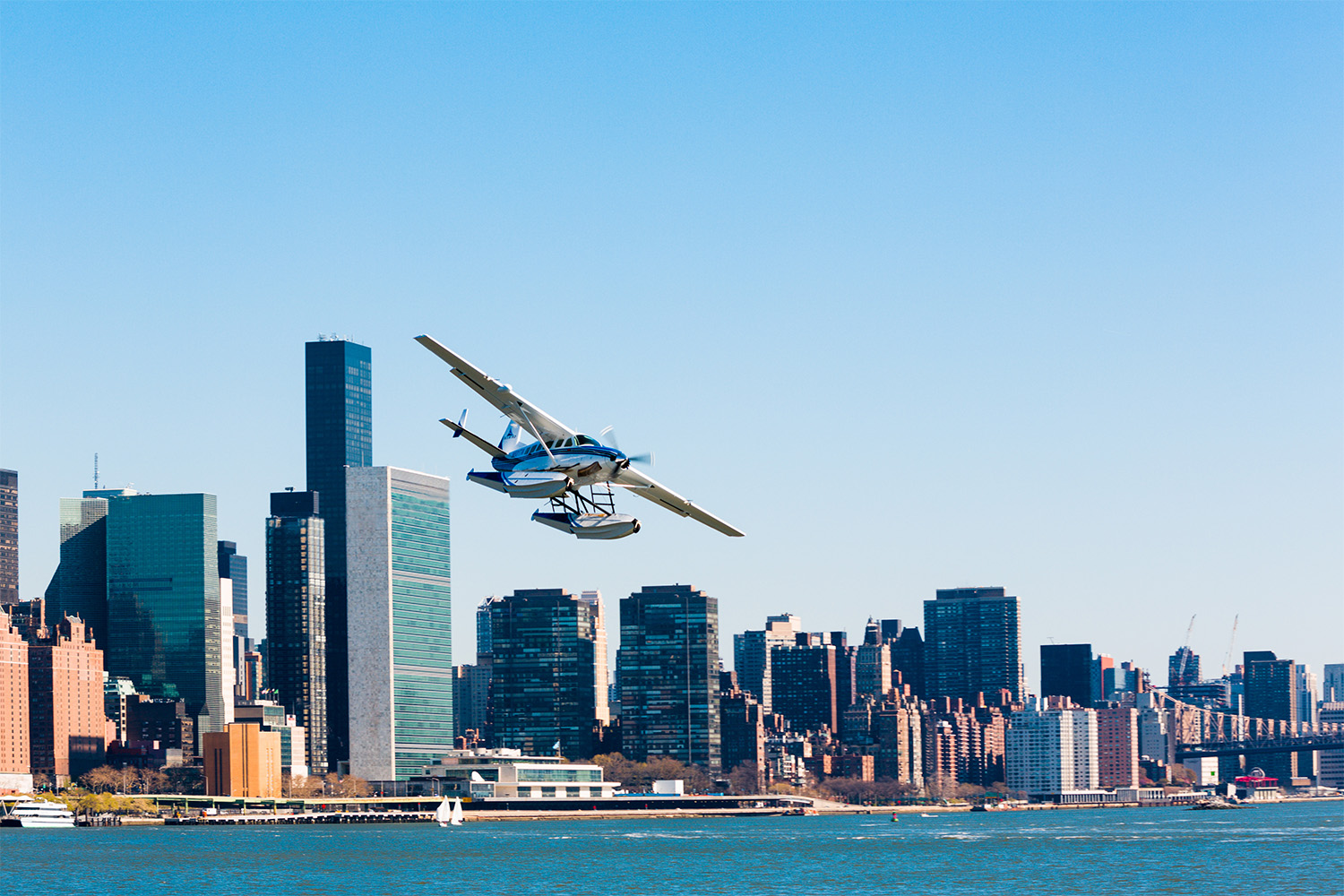I’m barefoot and sitting cross-legged in a cave temple, Pura Gunung Kukus Gwa Gong, hidden away in the southern hills of Bali. I’m wearing traditional Balinese temple garb including a sarong and an udeng, a wrapped head covering for men. There’s a woven offering tray of multicolored flowers and burning incense placed before me as the sharp, hypnotic chime of a bell rings in my ears, spliced with the rhythmic chanting of a priest who has agreed to meet with me and provide a blessing.
Large urns scattered throughout the cave collect what’s said to be the holy water dripping through the limestone rock. I’m praying and meditating, while trying my best to keep up with the rituals of the experience, including grabbing particular colors from the rainbow of flowers before me at particular times, drinking from and splashing myself with the holy water, and placing flowers behind my ear and wet rice onto my forehead.
You can’t go to Bali without visiting a few Hindu temples along the way. It is the island of 1,000 temples, after all. In this case, I was amid a personal “Journey to Enlightenment,” one of the signature experiences tailor-made for guests at Alila Villas Uluwatu. I was shepherded to three temples — in addition to Uluwatu Temple, one of Bali’s largest and most well known, two were entirely off the tourist track — and received a blessing from a priest at each. “This is how we can show people what life is like in Bali,” my guide tells me.
After a whirlwind morning of prayer, meditation and offerings, do I feel any different? I feel light. I feel at ease. Maybe I have been purified. Maybe not. What I can say with certainty is that after retreating back to Alila, a sleek and contemporary clifftop resort in Uluwatu, I feel content. At least there’s that. The property of villas makes for an idyllic locale to ponder life’s mysteries and search for greater truth — or to order a tropical drink at an infinity pool looking down upon the famed crashing waves along Bali’s southwestern coast. Maybe both.
At Alila, rows of white-washed lodgings with plunge pools in walled gardens are interspersed between stone walkways with flowing channels of water running beside them. There’s a 600-step staircase leading down to a small beach below for intrepid guests willing to make the hike, and the property’s Sunset Cabana Bar, draped over the edge of the cliff, lives up to its billing by serving up those sunsets alongside craft cocktails. Its signature Warung restaurant — a “warung” is a simple roadside restaurant or food shack, so you’ll pass thousands of warungs in Bali — highlights traditional Indonesian flavors and dishes, and every meal is accompanied by a conglak tray loaded with a dozen sambals, condiments and snacks. That’s more the speed of my typical spiritual routine.
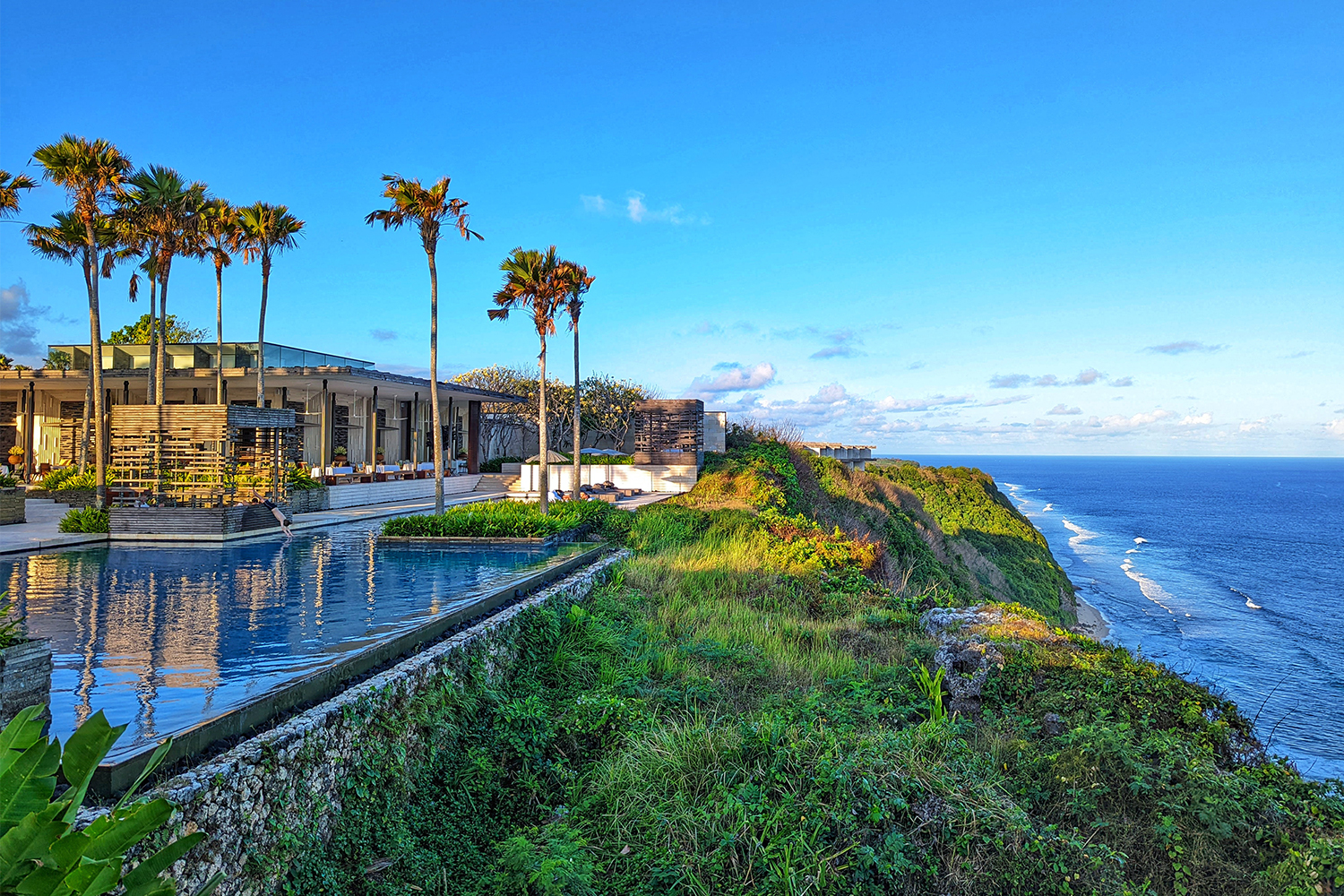
The Island of 1,000 Temples
Another day, while staying in Ubud, a town to the north, I visited Pura Tirta Empul, a temple known for its holy springs and water purification ceremonies. My guide Adi coached me through the procedure while helping me to understand the particulars of Hinduism in Bali. “We have three types of temples in Bali: the family temple that’s used every day, and is in every home; the village temples, which are very important for festivals and ceremonies; and public temples, which are open every day and not only for Hindu people,” he says. “There are also three things that are important at temples: flowers, water and fire.”
For the water purification, visitors pay a small fee and change into a traditional green sarong adorned with a red sash. A series of 12 fountains flows forth from pools where the holy spring water is collected, and you wash yourself and take a moment at each, passing from one to the next. The progression culminates with the final and most important fountain, the water of which comes straight from the spring. Each fountain has a specific purification purpose, but it’s not necessary to know the intricate details of one or another, as long as you avoid a separate set of fountains intended only for ceremonies pertaining to death and cremation.
Even with the crowds, it’s a peaceful and serene experience. The smell of incense fills the air as butterflies flutter around, little fish in the ponds nibble at your feet whether you want them to or not and locals fill up large plastic jugs of holy water from the fountain to take home for later use. Life seems to slow down, and you can feel yourself moving closer to nature and your surroundings, basking in the sun and the presence of the ancient banyan tree at the complex’s entrance. Did I feel purified? Maybe. Seeing my eagerness to participate, though perhaps my skepticism of the outcome, Adi has my back at least. “Even if you do not believe, that is OK,” he tells me. “We welcome you here.”
After the water purification, Adi leads me to a few of Ubud’s well-known waterfalls. I’m hoping to get some good shots of the falls, but if you’re an American tourist visiting a waterfall in Bali, it’s assumed that what you really want is influencer-y photos of yourself posing in front of them. Halfway against my will, then, I’m led through a series of standard photo-ops, the guides knowing all the spots and angles and merrily click-click-clicking away. Purified? I guess not. But I did get some excellent content.
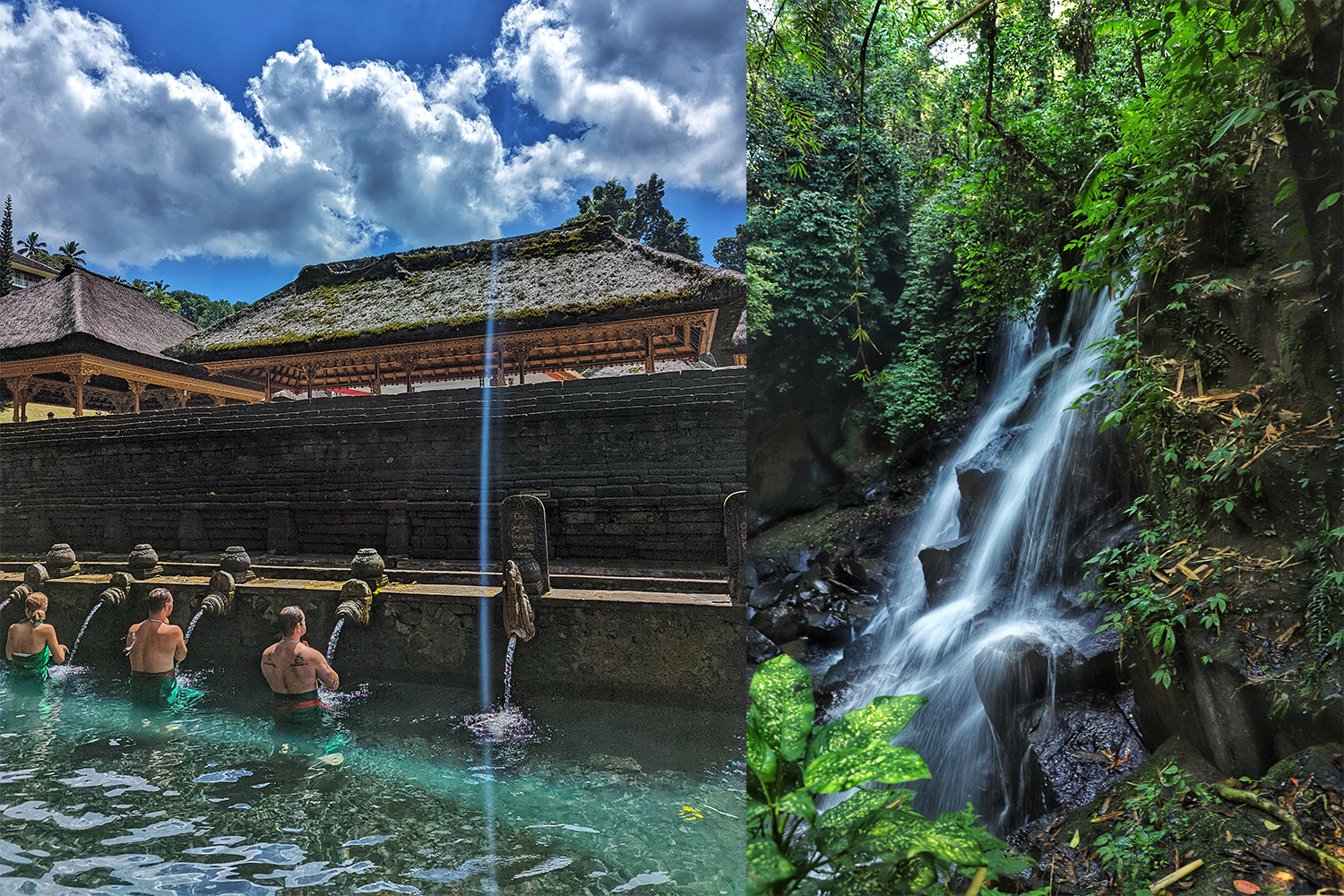
The Many Traveler Tropes in Bali
Spirituality seekers are but one of many contingents of visitors to the island, alongside the hedonistic partiers, the yoga retreaters, the backpackers, the food fiends, the luxury resort hoppers. I’m a mix of a few, and it’s easy to find the right spot on the island to cater to your particular areas of interest.
It’s important to note, though, that Bali is larger than many imagine, and more to the point, getting from one place to another takes far longer than you’re likely envisioning. Choose an area or two and a corresponding vibe instead of trying to do it all, and plan for a few half- or full-day excursions to explore some key spots on the island where you’re not staying. Pro tip: the Grab app is your friend, for affordable Uber-style car service, even more affordable scooter rides and a number of other services.
Speaking of scooters, for those planning to partake in the moped lifestyle, as long as you understand it’s an entirely rules-free driving system, you’ll be fine. It makes for both a perilous and exhilarating ride, but a mundane enough one that you’ll pull up alongside a helmet-less grandmother toting around a few of her grandchildren. Google Maps with voice directions comes in handy, though keep in mind if you’re on the moped setting (yes, there’s a moped setting out there) it’ll navigate you through the shortcuts. Which is great! But without warning you may turn off from a normal road onto a 12-inch wide sliver of concrete cutting across a rice paddy with a five-foot drop off on either side. Maybe taking the long way and weaving through some traffic is the better option after all.
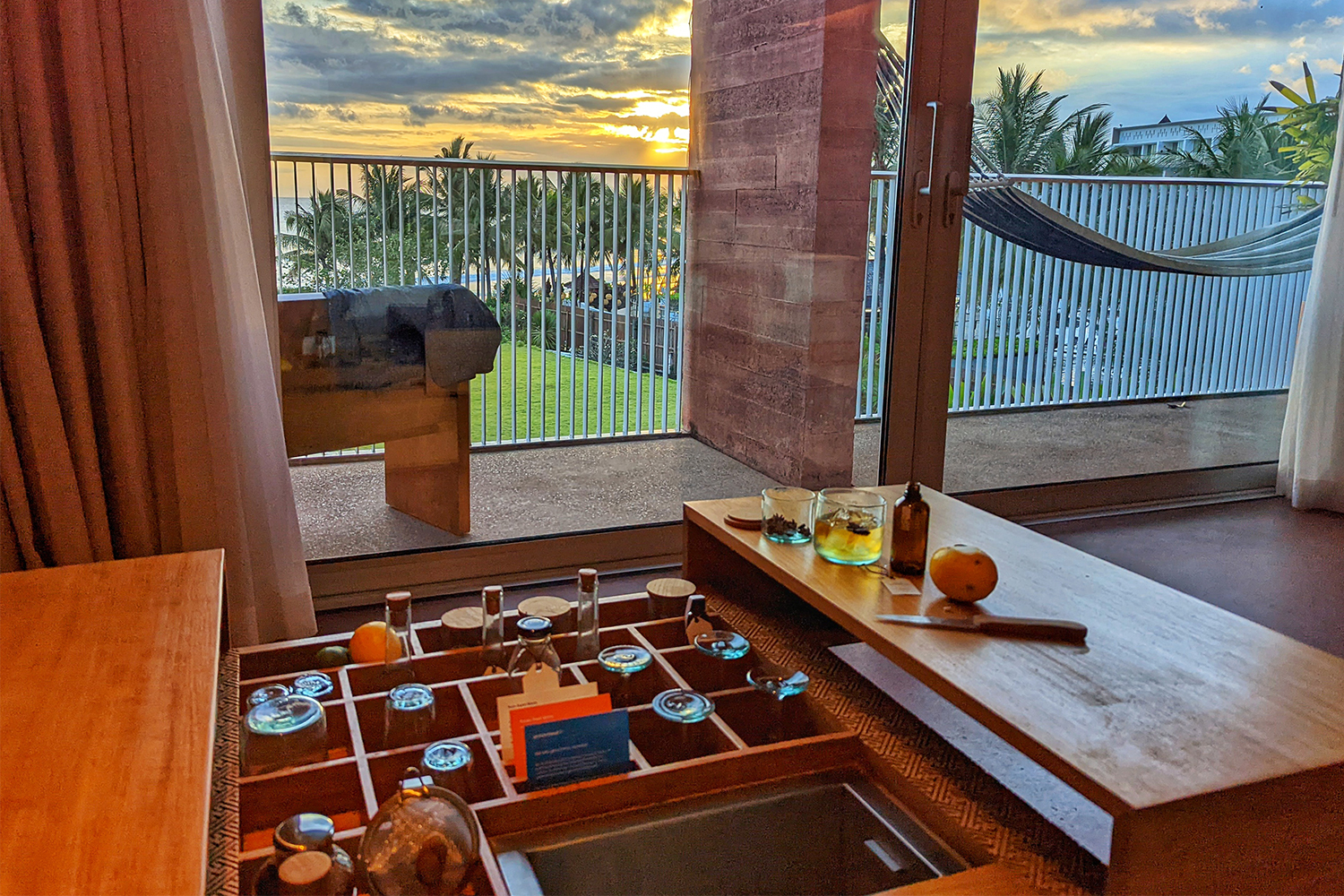
Choose Your Own Adventure, From Partying to Surfing
When you’re choosing where to stay, it’s not just Ubud versus the beach, either. The latter category includes a spectrum of potential choices, including Seminyak, Canggu, Jimbaran, Nusa Dua and Uluwatu, for starters. When you choose your area, you’d be wise to choose a hotel that meshes in with that area and the lifestyle for which it’s known.
Take Desa Potato Head in Seminyak as a case in point. This popular beach area is known for its restaurants, bars and nightlife, and Potato Head itself was the first major beach club on Bali. Desa translates to “village,” and they’ve continued expanding their footprint enough to that point that the name rings true, with an initial hotel building dubbed their Suites and, more recently, a larger wing with Studio rooms. In between them is a community courtyard and gathering place that’s open to the public. Then there’s the beach club, as well as a quieter infinity pool and lounge area exclusive to hotel guests.
Studio rooms feature deep wooden soaking tubs adjacent to the bed, with sauna-like wood styling throughout the rest of the space. Balconies offer hammocks and ocean views, and rooms feature what may be the world’s best minibars, serving as fully operational, in-room cocktail battle stations with batched cocktails, infused spirits, ice, tools, garnishes, glassware and mixers. Open up the balcony door to soak up the sounds of crashing waves, and mix yourself a perfectly proportioned drink at your leisure. The vibes? Immaculate.
Potato Head may encourage the party lifestyle with its beach club, an in-house DJ studio, and a rooftop bar and events space, but it contrasts that with a number of wellness programs, including an all-day juice bar — jamu, technically, a turmeric and ginger health drink — plant-based cuisine and fitness classes. Whether you prefer your good times high-octane or low-key, they’re good for the planet. The property has a strong sustainability commitment, beginning at check-in when guests receive a recycled tote bag and refillable water bottle, and learn about how much of the hotel’s décor and amenities are upcycled, including with an on-site processing center.

Back in Uluwatu, the area is renowned for its waves, and the Uluwatu Surf Villas are the ideal jumping off point for those looking to participate. The hotel’s philosophy is “stay + eat + flow,” and you’ll enjoy all three phases of the routine. Stay in a multi-bedroom villa with its own pool; eat and hang at the all-day Mana restaurant, with the hotel’s main pool and a terrace with an unbeatable panorama; and flow with daily yoga sessions in an outdoor pavilion and a Board Room to stash your surfing gear or get complimentary access to theirs.
Those beautiful waves below are busy with lineups, but everyone else had to paddle out from someplace 30 or 40 minutes away. Meanwhile, you and your surfing comrades can roll right up, walking down the hotel’s private cliffside staircase directly to the ocean. Casual hobbyists are welcome, though it’s also a place that brings in world-class surfers who relish its unique combination of wave access with the luxe villa life.
Jimbaran Bay is a popular resort area, known for its beaches, sunsets and its fish grill joints on said beaches. Ayana is the type of big, do-it-all resort that will help you maximize your time. There are rooftop pools and two-tiered infinity pools, restaurants specializing in Jimbaran-style grilled seafood, a secluded swath of beach that hotel guests can ride an outdoor elevator down to, and of course Rock Bar, the most famous, see-and-be-seen sunset and cocktail spot on the island.
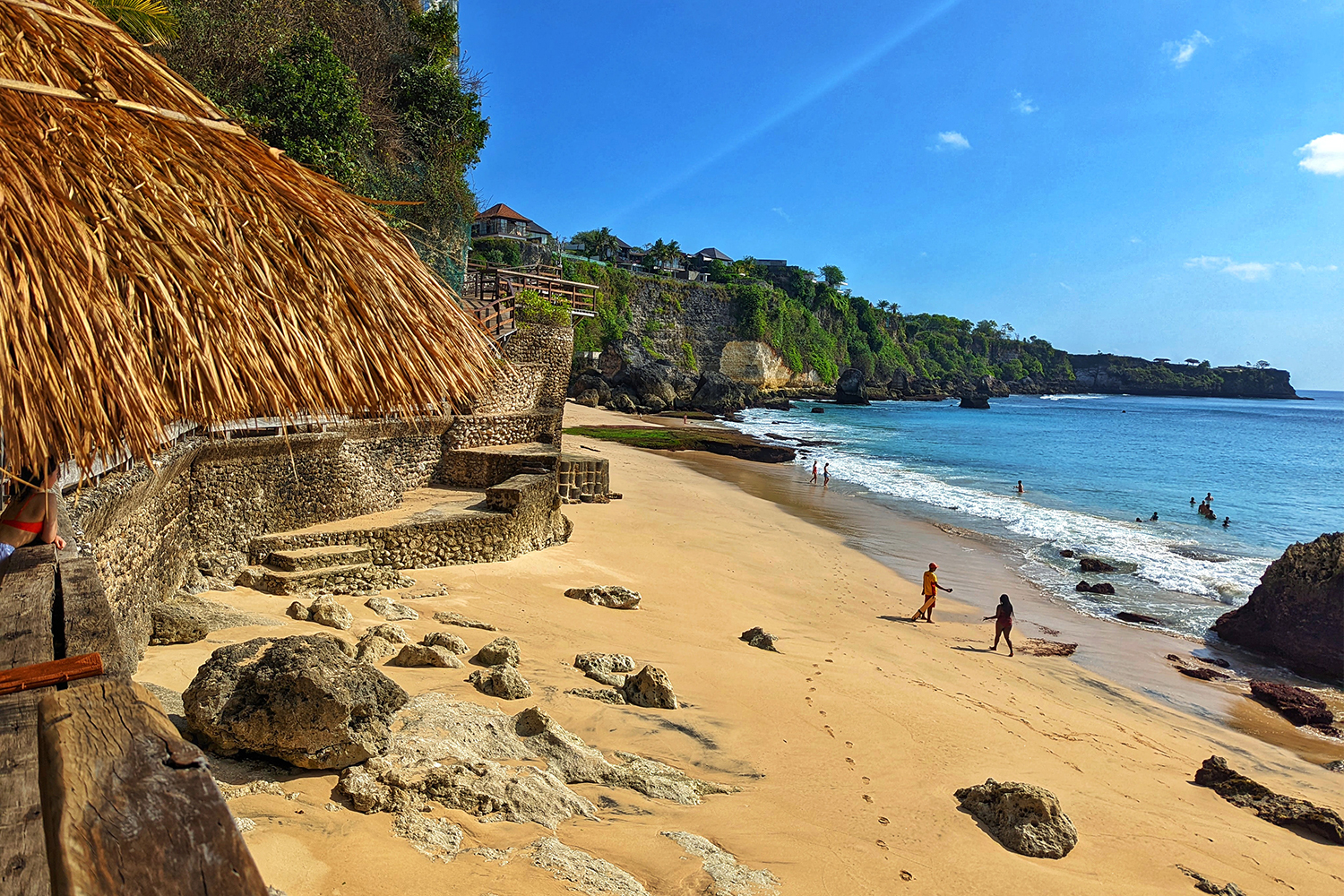
The mega resort is broken up into several individual hotels, also including Rimba and The Villas, but because of the size of its sprawling, 19-hectare grounds, and how distinct all of its enclaves are, it doesn’t feel like there are thousands of other guests sharing the area with you. A fourth section of the resort is set to open this fall, and when it does, Ayana will have the largest guest capacity on the island, with nearly 1,000 rooms. You can stay in your own little section of the property or ride around on the resort’s tram service to explore them all.
If you’re considering Nusa Dua, with its pristine beaches and swanky stays, then The St. Regis Bali Resort is where you should be headed. It’s unimpeachable.
The property bills itself as “Bali’s finest address,” and it makes a pretty damn strong argument for itself. Imagine an enormous beachfront villa with a full walled-in backyard including a plunge pool, relaxation gazebo, numerous day beds and lounging areas, and a path leading to a gate that opens up directly onto the powdery white sand beach of your Balinese dreams. Villas even have their own serviced chairs reserved for them right out front.
There’s also a huge 3,600-square-meter saltwater lagoon that weaves around the center of the property, with a wing of villas which open onto it, a lush tropical park with a hammock garden and walking trails, buggy service to get you around, and of course, the St. Regis butler treatment. Elsewhere, partake in the rest of the trappings the St. Regis specializes in around the world, such as its nightly Champagne ritual, or those that are more unique to the property in Bali, such as a nightly fire dance performance.
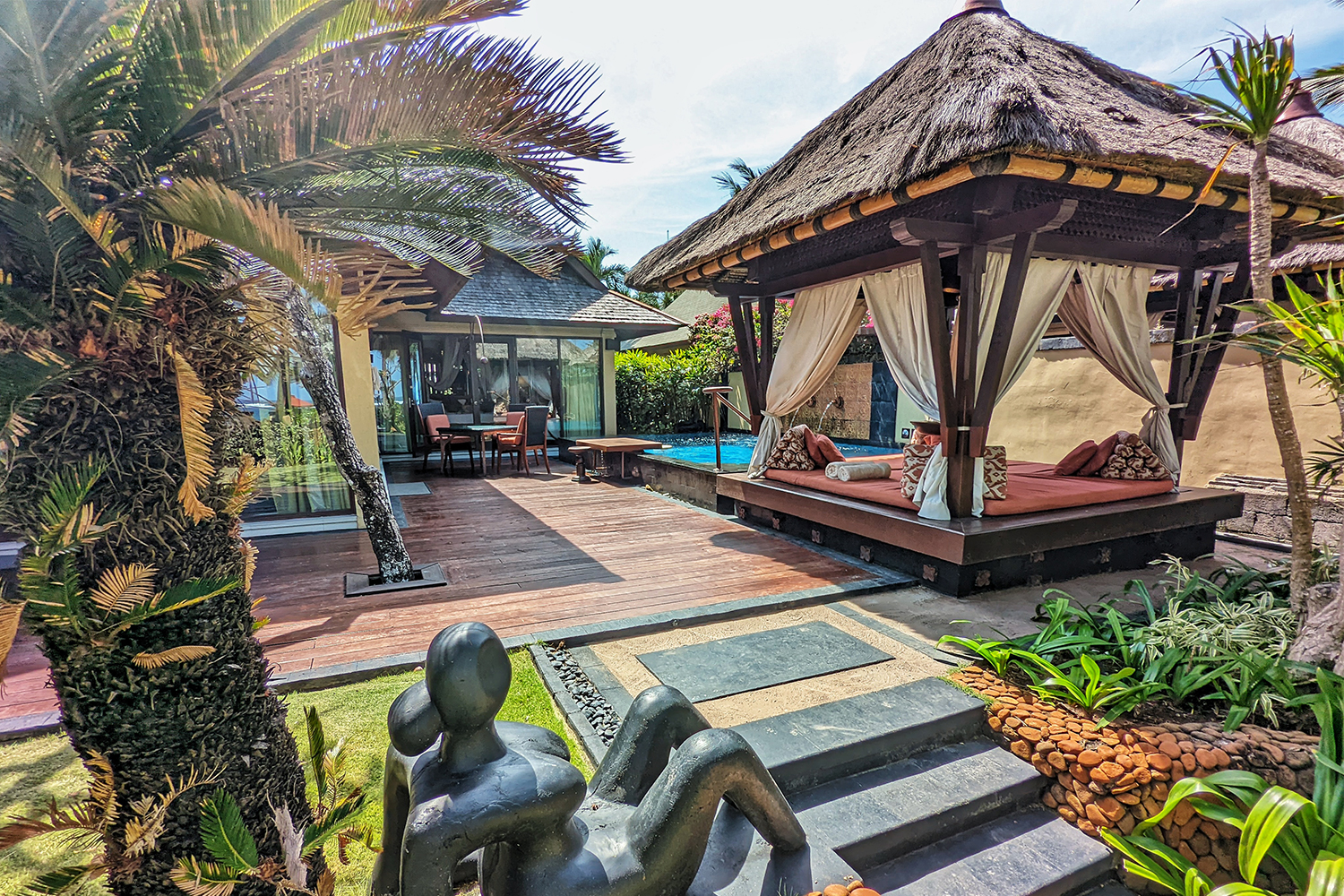
Reserve a dinner at Dulang, an experiential meal inspired by Balinese palace feasts, with a multitude of courses and small plates, tableside prepped sambal — take that, tableside guac — and traditional music and dancers. Kayuputi, its main restaurant, is known for epic weekend brunches, and when you’ve eaten entirely too much, you can head straight to the Iridium Spa, an entire complex with a full assortment of saunas and steam rooms, and an 11-step outdoor Aqua Vitale pool treatment area which can be privately reserved.
While the discussion thus far has centered on some of Bali’s excellent beaches, you’d be remiss if you skipped Ubud. It’s the spiritual beating heart of the island, and its jungle and rice paddy environs, and dense, shop-lined streets need to be experienced. Visit the temples and the waterfalls. Go to the Monkey Forest. Sign yourself up for a cooking class. Do food market tours and night market visits and let yourself get lost a bit. Befriend a few well cared for street dogs, resident pets of entire villages rather than single households who roam the roads with their own spiritual calm.
There’s a who’s who of top-notch five stars in the area — the best I visited was the Four Seasons Resort Bali at Sayan — but it’s also an excellent locale to opt for an Airbnb. Snag a villa and a moped, and give yourself a few days to cruise around on your own. It’s all too easy to fall into a slower, more relaxed way of life, and to understand how a couple of days well spent could turn into a couple of months.
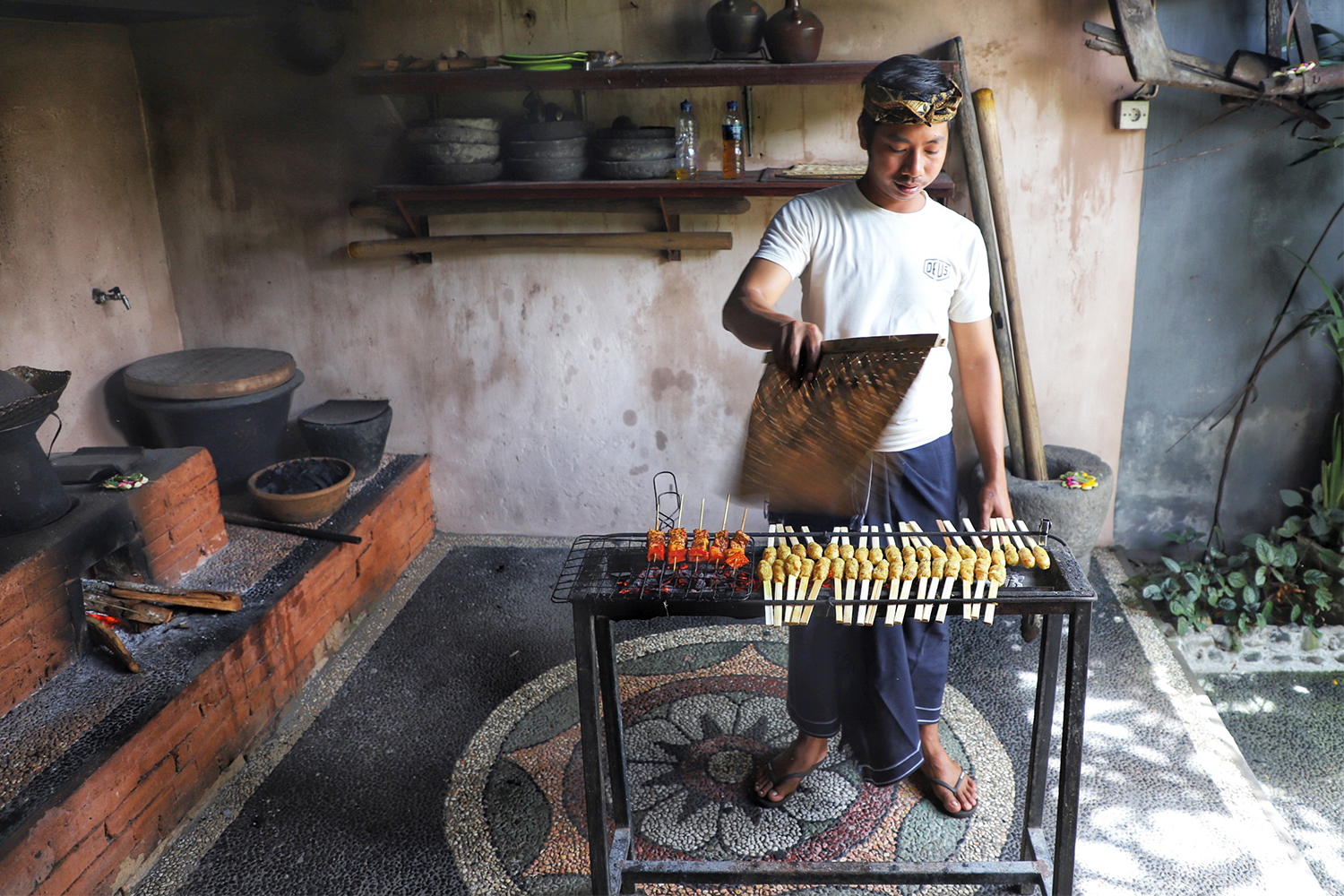
Is the Return of Tourism to Bali a Good Thing?
It’s impossible to talk about the return of tourism to Bali without talking about the return of overtourism to Bali. Traffic is fierce on tiny roads and through small villages never designed to allow for it. There are scores of tourist-trap bars and restaurants and shops, and the legions of travelers who are more than happy to oblige them.
Yet, time and time again, the locals I spoke to were unanimously grateful for those tourists and hoped that tourism would come back in full. But, I’d ask, don’t you miss how open the traffic-free roads were? How quiet the beaches and temples were? Most people would laugh in response, and allow a sure, getting around was quick, but…. But it wasn’t a viable way of life.
Bali is the only place I’ve ever visited where every person I met, each and every local I interacted with, said “thank you” to me for visiting their destination. For choosing to travel there, for spending time on their island and flying around the world for the privilege.So is it overcrowded? Yeah, it can be. Is it what it was two decades ago? Probably not, for better and for worse. But the people of Bali have been waiting more than two years to reopen their doors to the world. They could not be more eager to have tourists returning to the island. They have been craving it, hoping for it, counting down the days until it happened. Their livelihoods depend on it. So go to Bali, traffic and crowds be damned. And thank them for having you.
This article was featured in the InsideHook newsletter. Sign up now.
